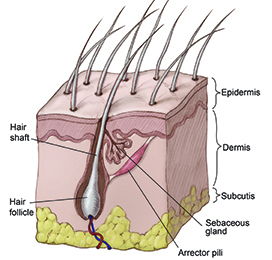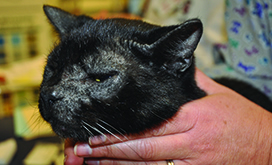Feline Skin Diseases
Skin diseases, or dermatopathies, are relatively common in cats.
Studies indicate that between 6 and 15 percent of feline patients have at least one dermatopathy and many cats suffer from more than one. Among cats presented to the dermatology service at the Cornell University Hospital for Animals, for instance, a recent study showed that 22 percent had evidence of two skin diseases and 6 percent have three distinctive skin diseases.
The skin is the largest organ in a cat’s body, comprising up to ¼ of its body weight. This amazing organ provides a protective barrier to the environment and regulates body temperature, among other important functions. The skin is composed of the epidermis (the top layer that provides protection), the dermis (the supportive layer underneath the dermis that provides nourishment to the epidermis), the subcutis (the innermost layer that contains protective and insulating muscles and fat), and various appendages. The appendages include claws, sebaceous glands that lubricate the skin and hair, and tiny muscles called arrector pili that can make the hair stand on end (see Figure 1).
A number of conditions, ranging from parasites to allergies, can cause skin disease in cats, and the prevalence of each condition varies with geographic location. In upstate New York, at the Cornell University Hospital for Animals, for example, the most common causes of skin disease in cats seen by dermatology specialists are allergies to airborne particles, food, or flea and mosquito bites. At private practices in Canada and the United Kingdom, on the other hand, studies show that abscesses are the most common cause of skin disease in feline patients.
A cat’s lifestyle, gender, and breed can also affect their risk of various skin conditions. Compared with indoor cats, cats allowed outdoors have a greater chance of infestation by external parasites such as fleas, and a higher risk of injury and abscesses from fighting with other cats or animals. In addition, male cats are more likely than female cats to engage in aggressive behavior that may result in bite wound-induced abscesses. Finally, certain breeds, such as Himalayans, may be more prone to skin disease than other breeds of cats.
Clinical Signs
Common signs of skin disease in cats include:
- Excessive scratching, licking, or chewing of the fur,
- Redness and swelling of the skin,
- Loss of fur,
- Scabby, scaly, or flaky skin, and
- Swellings or bumps on the skin (Figure 2).
Diagnosis
Figuring out the cause of skin disease in cats can be difficult, although in some cases the cause is more easily determined. Careful consideration of the history of the illness, a physical examination, the results of diagnostic tests, and, in some cases, response to treatment or modification of diet or lifestyle is important. The history can provide information about potential exposure to things that may cause skin disease (including fleas), about behaviors that may suggest a cause (like scratching, which suggests itchiness), and about response to therapy. A careful physical examination is necessary to evaluate the nature and pattern of skin abnormalities (including loss of hair, redness, and presence of parasites), that may suggest a cause for the skin disease. Depending on the history and physical examination, diagnostic tests may be recommended to rule out specific causes of skin disease. In some cases, diagnosis may rely on monitoring how a cat responds to a trial of medical therapy or of dietary modification.
Treatment
The treatment of feline skin disease depends on its specific cause. Flea infestation is treated by using appropriate flea control products to eliminate fleas from both the cat and its environment. Food allergies are usually treated by instituting a diet that does not contain components to which a cat is allergic. Abscesses are treated by draining the infected site and giving the cat antibiotics to fight bacterial infection, and fungal disease is usually treated with anti-fungal medications. In many cases, the cause of skin disease in cats may be communicable to other cats (and, in some cases, to people), so preventing transmission to other animals or humans is often an important component of a treatment plan.
No matter the specific cause, cats with skin disease often suffer from dermatitis, or skin inflammation. This inflammation may result from the process that starts the skin disease, as in the case of some food allergies that cause inflamed skin, or it may be the result of a cat scratching or biting itself in response to irritation stemming from the disease. In either case, inflammation promotes itchiness, and the resulting scratching can cause further skin damage, which can start a vicious cycle of inflammation, skin damage, and more inflammation. This makes controlling the itchiness of skin disease an important treatment goal for many cats with skin disease. Careful consultation with your veterinarian can help you arrive at the best strategy to help keep your cat out of the vicious cycle of itching, injury, and inflammation.
Prognosis
Depending on the cause and severity of feline skin disease, the prognosis (predicted outcome) for cats with these conditions is often favorable. Although there are rare exceptions in which feline skin disease may be an indicator of a more serious illness that may carry a less favorable prognosis, careful compliance with the recommendations of your veterinarian will often result in a resolution of the problem in affected cats.
Updated 2023






